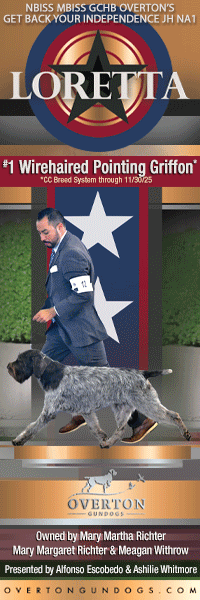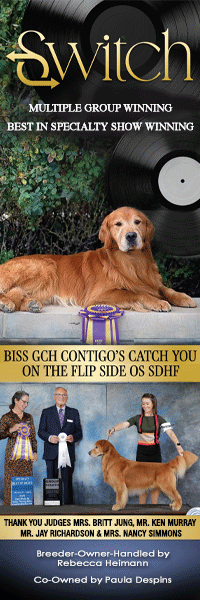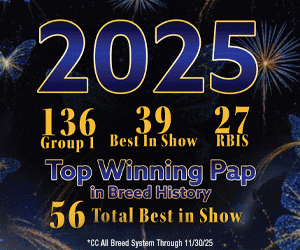Knowledge is Power …and More
To Read The Complete Article Click Here
By Pat Hastings
 One of the most significant pearls of wisdom I was fortunate to receive over the years was in these words: A sound dog will age more gracefully, be less likely to break down from stress or injury, experience less fatigue and greater efficiency in work, and stay healthier and more attractive throughout its life. The originator of this most eloquent of reasons to breed carefully and thoughtfully has my deepest respects. It is an essential axiom not only in a conscientious breeding program but also in the commitment to structurally evaluate – as knowledgeably and objectively as possible – each litter bred. I do not mean to take anything away from type, however.
One of the most significant pearls of wisdom I was fortunate to receive over the years was in these words: A sound dog will age more gracefully, be less likely to break down from stress or injury, experience less fatigue and greater efficiency in work, and stay healthier and more attractive throughout its life. The originator of this most eloquent of reasons to breed carefully and thoughtfully has my deepest respects. It is an essential axiom not only in a conscientious breeding program but also in the commitment to structurally evaluate – as knowledgeably and objectively as possible – each litter bred. I do not mean to take anything away from type, however.
Type is undeniably at the center of the dog show world – and it should be. After all, breed conformation is founded on type. However, type without a sound, functional structure is rather like breeding balloon animals – producing a recognizable form lacking in substance. Even dogs bred as companion animals need good health in order to be companionable. Function is as important as type.

Certainly we’ve all heard this before. But what does it take to develop both function and type in a breeding program? Engineers can relate to the essential design of the dog. The dog’s structure serves a purpose; if that structure is too weak or improper to live up to its purpose, it is more likely to break down. It is cruel to ask any dog to perform any task for which its structure is poorly equipped. The reason is simple: because the human-animal bond is strong, most dogs will do all we ask for as long as they can – they’ll jump, herd, hunt, run, walk the neighborhood, jog the track, or take to the agility course until they can no longer do so. They will keep going until their physical structure is incapable of one more step. How soon they will reach that point depends largely on our awareness of and respect for their inherent strengths and weaknesses. What happens when dogs reach the point of breakdown? The average owner’s initial tendency is to get frustrated with the dog. More times than I can count, my husband and I were approached by owners wanting to know why their dogs suddenly wouldn’t take the jumps after so many good performances. These people wanted to know why their dogs were suddenly being disobedient or just plain lazy. In almost every case we encountered, the dog’s structure had broken down. Most people are genuinely unaware of their dogs’ physical condition when such behavior patterns begin to emerge. They don’t realize the body is simply telling the dog it cannot do another jump.
I firmly believe that if more breeders had a working knowledge of canine structure, we would see far fewer structural weaknesses in the show ring. Structural weaknesses are not limited to mediocre show dogs – they can be found in top-winning dogs. A judge is compelled to judge a dog on its qualities, but weaknesses must be taken into consideration at some point. After all, conformation is intended to advance quality in breeding. If structural weaknesses are overlooked because type is everything, both breeder and judge are helping to perpetuate these weaknesses and are potentially creating serious problems within an entire breed.

It doesn’t stop with the show ring or the obedience ring or the field trial. We all cry out against puppy mills, yet some of the most crippled pet dogs I have come in contact with were purchased from reputable breeders who were completely unaware of the structural weaknesses in the puppies they were selling. The owner bears the financial and emotional burden of surgeries or pain killers and of deciding at which point the dog would be best served by euthanasia. Puppy mills are interested in profits. A breeder’s first priority is to the breed. The distinction is vast and the responsibility enormous. No breeder or breed is best served by relying entirely on conformation wins. Breed to a winning stud dog with structural weaknesses and your breeding program goes the way of trouble. And if those weaknesses are not recognized as such, does that make it OK? What do you think?
One of the worst tragedies in the dog world is when a structural problem becomes so pervasive in a breed that it is gradually accepted as a normal aspect of the breed. We ought to be ashamed of ourselves!
The answer lies in education, in making an effort to learn correct structure and the consequences of incorrect structure. For example, a dog acquired for jumping in obedience or agility should have no looseness in the elbows or lack in prosternum, both of which can cause stretched and damaged tissue in the front assembly.
 A dog with slipped hocks should never be expected to perform coursing, herding, or repetitive jumping because the lack of stability in the hock joint damages the tissue integrity and eventually causes bone or joint deterioration. A sporting dog with a ewe neck will eventually be incapable of carrying a bird. And high shoulders are one of the most destructive weaknesses that a dog in harness can have.
A dog with slipped hocks should never be expected to perform coursing, herding, or repetitive jumping because the lack of stability in the hock joint damages the tissue integrity and eventually causes bone or joint deterioration. A sporting dog with a ewe neck will eventually be incapable of carrying a bird. And high shoulders are one of the most destructive weaknesses that a dog in harness can have.
A dog bred to go-to-ground is fairly useless if its loin is too short or nonexistent. A herring gut or high hocks diminish stamina. A weak underjaw prevents a strong grasp. An over-angulated rear, which creates sickle hocks, causes a poorly synchronized gait, which destroys its efficiency. Shoulders set too close together make it difficult for a dog to eat out of a pan on the floor and impede the ability of a tracking dog to keep its nose to the ground. A tail set too low interferes with an effortless gait. A tail set too high can prevent a dog from pulling a cart.
All dogs have imperfections, as do we all. However, it is important to view those imperfections in relation to what the dog will be asked to do. If we cannot recognize structural weaknesses or faults in our dogs, we risk the quality of their lives, not to mention the quality of our breeding programs. Thus knowledge is more than power – it is a substantial component to the future well-being of our breeds.
Short URL: http://caninechronicle.com/?p=19315
Comments are closed











